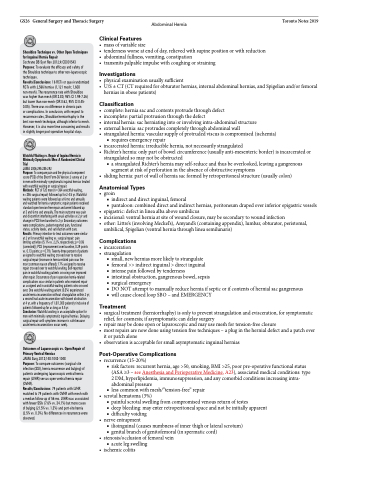Page 428 - TNFlipTest
P. 428
GS26 General Surgery and Thoracic Surgery Abdominal Hernia Toronto Notes 2019
Shouldice Technique vs. Other Open Techniques for Inguinal Hernia Repair
Cochrane DB Syst Rev 2012;4:CD001543 Purpose: To evaluate the efficacy and safety of the Shouldice technique to other non-laparoscopic techniques.
Results/Conclusions: 16 RCTs or quasi-randomized RCTs with 2,566 hernias (1,121 mesh; 1,608 non-mesh). The recurrence rate with Shouldice was higher than mesh (OR 3.80, 95% CI 1.99-7.26) but lower than non-mesh (OR 0.62, 95% CI 0.45- 0.85). There was no difference in chronic pain
or complications. In conclusion, with respect to recurrence rates, Shouldice herniorrhaphy is the best non-mesh technique, although inferior to mesh. However, it is also more time consuming and results in slightly longer post-operative hospital stays.
Watchful Waiting vs. Repair of Inguinal Hernia in Minimally Symptomatic Men: A Randomized Clinical Trial
JAMA 2006;295:285-292
Purpose: To compare pain and the physical component score (PCS) of the Short Form-36 Version 2 survey at 2 yr in men with minimally symptomatic inguinal hernias treated with watchful waiting or surgical repair.
Methods: RCT of 720 men (n=364 watchful waiting, n=356 surgical repair) followed up for 2-4.5 yr. Watchful- waiting patients were followed up at 6 mo and annually and watched for hernia symptoms; repair patients received standard open tension-free repair and were followed up
at 3 and 6 mo and annually. The main outcome was pain and discomfort interfering with usual activities at 2 yr and change in PCS from baseline to 2 yr. Secondary outcomes were complications, patient-reported pain, functional status, activity levels, and satisfaction with care.
Results: Primary intention-to-treat outcomes were similar at 2 yr for watchful waiting vs. surgical repair: pain
limiting activities (5.1% vs. 2.2%, respectively; p=0.06 [corrected]); PCS (improvement over baseline, 0.29 points vs. 0.13 points; p=0.79). Twenty-three percent of patients assigned to watchful waiting crossed over to receive surgical repair (increase in hernia-related pain was the most common reason offered); 17% assigned to receive repair crossed over to watchful waiting. Self-reported
pain in watchful-waiting patients crossing over improved after repair. Occurrence of post-operative hernia-related complications was similar in patients who received repair as assigned and in watchful-waiting patients who crossed over. One watchful-waiting patient (0.3%) experienced acute hernia incarceration without strangulation within 2 yr; a second had acute incarceration with bowel obstruction at 4 yr, with a frequency of 1.8/1,000 patient/yr inclusive of patients followed up for as long as 4.5 yr.
Conclusion: Watchful waiting is an acceptable option for men with minimally symptomatic inguinal hernias. Delaying surgical repair until symptoms increase is safe because acute hernia incarcerations occur rarely.
Outcomes of Laparoscopic vs. Open Repair of Primary Ventral Hernias
JAMA Surg 2013;148:1043-1048
Purpose: To compare outcomes (surgical site infection (SSI), hernia recurrence and bulging) of patients undergoing laparoscopic ventral hernia repair (LVHR) versus open ventral hernia repair (OVHR).
Results/Conclusions: 79 patients with LVHR matched to 79 patients with OVHR with mesh with a median follow-up of 56 mo. LVHR was associated with fewer SSIs (7.6% vs. 34.1%) but more cases of bulging (21.5% vs. 1.3%) and port-site hernia (2.5% vs. 0.0%). No differences in recurrence were observed.
Clinical Features
• massofvariablesize
• tendernessworseatendofday,relievedwithsupinepositionorwithreduction • abdominal fullness, vomiting, constipation
• transmitspalpableimpulsewithcoughingorstraining
Investigations
• physicalexaminationusuallysufficient
• U/S±CT(CTrequiredforobturatorhernias,internalabdominalhernias,andSpigelianand/orfemoral
hernias in obese patients)
Classification
• complete:herniasacandcontentsprotrudethroughdefect
• incomplete: partial protrusion through the defect
• internalhernia:sacherniatingintoorinvolvingintra-abdominalstructure
• externalhernia:sacprotrudescompletelythroughabdominalwall
• strangulatedhernia:vascularsupplyofprotrudedviscusiscompromised(ischemia)
■ requires emergency repair
• incarceratedhernia:irreduciblehernia,notnecessarilystrangulated
• Richter’shernia:onlypartofbowelcircumference(usuallyanti-mesentericborder)isincarceratedor
strangulated so may not be obstructed
■ a strangulated Richter’s hernia may self-reduce and thus be overlooked, leaving a gangrenous
segment at risk of perforation in the absence of obstructive symptoms
• slidinghernia:partofwallofherniasacformedbyretroperitonealstructure(usuallycolon)
Anatomical Types
• groin
■ indirect and direct inguinal, femoral
■ pantaloon: combined direct and indirect hernias, peritoneum draped over inferior epigastric vessels
• epigastric: defect in linea alba above umbilicus
• incisional:ventralherniaatsiteofwoundclosure,maybesecondarytowoundinfection
• other:Littre’s(involvingMeckel’s),Amyand’s(containingappendix),lumbar,obturator,peristomal,
umbilical, Spigelian (ventral hernia through linea semilunaris)
Complications
• incarceration • strangulation
■ small, new hernias more likely to strangulate
■ femoral >> indirect inguinal > direct inguinal
■ intense pain followed by tenderness
■ intestinal obstruction, gangrenous bowel, sepsis
■ surgical emergency
■ DO NOT attempt to manually reduce hernia if septic or if contents of hernial sac gangrenous ■ will cause closed loop SBO – and EMERGENCY
Treatment
• surgicaltreatment(herniorrhaphy)isonlytopreventstrangulationandevisceration,forsymptomatic relief, for cosmesis; if asymptomatic can delay surgery
• repair may be done open or laparoscopic and may use mesh for tension-free closure
• mostrepairsarenowdoneusingtensionfreetechniques–apluginthehernialdefectandapatchover
it or patch alone
• observationisacceptableforsmallasymptomaticinguinalhernias
Post-Operative Complications
• recurrence(15-20%)
■ risk factors: recurrent hernia, age >50, smoking, BMI >25, poor pre-operative functional status
(ASA ≥3 – see Anesthesia and Perioperative Medicine, A23), associated medical conditions: type 2 DM, hyperlipidemia, immunosuppression, and any comorbid conditions increasing intra- abdominal pressure
■ less common with mesh/”tension-free” repair • scrotalhematoma(3%)
■ painful scrotal swelling from compromised venous return of testes
■ deep bleeding: may enter retroperitoneal space and not be initially apparent ■ difficulty voiding
• nerveentrapment
■ ilioinguinal (causes numbness of inner thigh or lateral scrotum) ■ genital branch of genitofemoral (in spermatic cord)
• stenosis/occlusionoffemoralvein ■ acute leg swelling
• ischemiccolitis


